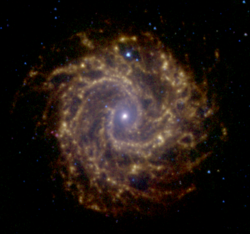NGC 3184
| NGC 3184 | |
|---|---|

Spiral galaxy NGC 3184 as observed with the Spitzer Space Telescope as part of the Spitzer Infrared Nearby Galaxy Survey. The blue colors represent the 3.6 micrometre emission from stars. The green and red colors represent the 5.8 and 8.0 micrometre emission from polycyclic aromatic hydrocarbons and possibly dustright.
|
|
| Observation data (J2000 epoch) | |
| Constellation | Ursa Major |
| Right ascension | 10h 18m 17.0s |
| Declination | +41° 25′ 28″ |
| Redshift | 0.001975 |
| Helio radial velocity | 592 ± 1 km/s |
| Distance | 39.8 ± 12 Mly (12.2 ± 3.7 Mpc) |
| Apparent magnitude (V) | 10.4 |
| Characteristics | |
| Type | SA(s)b: II |
| Apparent size (V) | 7′.4 × 6′.9 |
| Other designations | |
| UGC 5557 | |
NGC 3184 is a spiral galaxy approximately 40 million light-years away in the constellation Ursa Major. It has two HII regions named NGC 3180 and NGC 3181.
NGC 3184 houses a high abundance of heavy elements and (SN 1999gi) that was a magnitude 14 Type II supernova detected on December 9, 1999. Other supernovae in NGC 3184 include 1921B (mag 13.5), 1921C (mag 11) and 1937F (mag 13.5).
On May 31, 2010, Koichi Itagaki detected a magnitude 17 optical transient 33" east and 61" north of the center of NGC 3184 at coordinates 10 18 19.89 +41 26 28.8. This event may be an outbursting Luminous blue variable (LBV) star. Archival Hubble and Spitzer images of NGC 3184 seem to show no progenitor for optical transient SN 2010dn. SN 2010dn is just like SN 2008S and NGC 300-OT. On day 2, SN 2010dn had an unfiltered magnitude of 17.1, corresponding to a peak absolute magnitude of roughly -13.3.
...
Wikipedia
